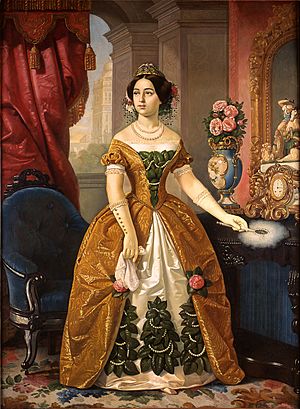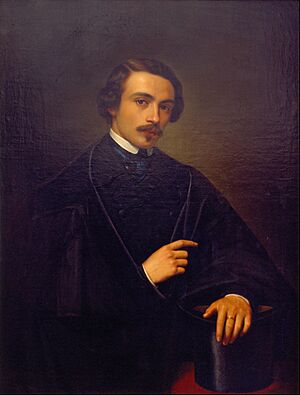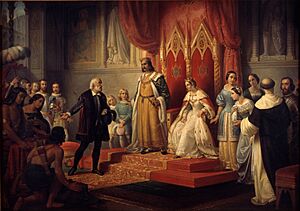Juan Cordero facts for kids
Juan Nepomuceno María Bernabé del Corazón de Jesús Cordero de Hoyos (born May 16, 1822, in Teziutlán, Mexico – died May 29, 1884, in Coyoacán, Mexico) was a famous Mexican painter. He was known for his murals and paintings in the Classical style. He started his art journey in Italy, studying in cities like Rome and Florence.
Contents
Biography
Juan Cordero was born on May 16, 1822. He was baptized on June 11, 1822, in Teziutlán, Puebla, Mexico. His parents were Tomás Antonio Cordero and María Dolores Hoyos Mier. Juan was the middle child of five siblings.
In 1839, Cordero married María del Los Ángeles Osio Arias Caballero. They had six children together: four daughters and two sons. He is buried in Mexico City.
Career as an Artist
Juan Cordero's parents first wanted him to join the family business. But they soon saw his amazing talent for art. So, they enrolled him in the Academia de San Carlos, a famous art school in Mexico.
By 1844, Juan was very skilled. His father even sold the family piano to send him to study in Rome, Italy. There, he attended the Accademia di San Luca. Both of these schools still have some of his paintings today.
In Rome, his main teacher was Pelegrí Clavé. Juan was also inspired by a group of artists called the Nazarene movement. Later, a former Mexican President, Anastasio Bustamante, noticed Juan's work. Bustamante helped Juan get a job with Mexico's office in the Holy See (the Vatican). This allowed Juan to stay and study in Rome until 1853.
Return to Mexico
Juan Cordero returned to Mexico with several large paintings. He showed them at the academy, and they were a big success! This caused a friendly competition with his former teacher, Clavé. Clavé had moved to Mexico and was now the director of the academy.
Soon, their competition became political. Cordero was a Liberal, while Clavé was a Conservative. Liberals generally wanted more freedom and change, while Conservatives preferred traditional ways. Cordero tried to become the academy's director instead of Clavé. He had the support of General Santa Anna, whose portrait he had recently painted. However, the academy's board decided to keep Clavé as director.
Between 1860 and 1867, Juan Cordero traveled across Mexico. He painted many portraits of people. After this, he started painting large murals. One famous mural was in the Church of Santa Teresa la Antigua. This church had been damaged by an earthquake and rebuilt.
Murals and Legacy
Juan Cordero was also friends with Gabino Barreda. In 1874, Barreda asked Cordero to paint a mural at the National Preparatory School. This school later became a key place for the Mexican muralism movement. Cordero's mural was called "The Triumph of Science and Industry Over Ignorance and Sloth." It was the first Mexican mural about a non-religious idea. Sadly, the school's director destroyed it in 1900. It was replaced by a stained-glass window.
After 1875, Cordero stopped showing his art in public. This might have been because of the political changes in Mexico around that time. Many years later, in 1945, a major exhibition of his work was held at the Palacio de Bellas Artes. Today, his paintings can be found in museums in Europe and Mexico.
Early Mexican Muralism
Mural painting in Mexico in the 1800s began as a way to respond to Spanish rule. Artists started mixing art with politics. They wanted to show their own Mexican identity, separate from their colonizers. This continued the tradition of mural painting often seen in Catholic churches.
These early murals started small. Then they grew into larger paintings on important social and political buildings. This idea of creating art to show national pride was strong when Cordero was a popular artist. These early murals aimed to show a positive picture of Mexico after it gained independence.
This idea also shaped education and political thinking for many artists. Juan Cordero's mural, "Triumph of Science and Labor Over Envy and Ignorance" (1874), is a good example. This painting showed how Mexico was growing with new science and technology. It also suggested that the government was using these advancements but not always treating its citizens well. This use of murals to share political ideas later inspired other famous Mexican muralists in the 1920s. These included artists like Diego Rivera, José Clemente Orozco, and David Alfaro Siqueiros.
Famous Artworks
Columbus in the Court of the Catholic Monarchs
Cordero's painting Columbus in the Court of the Catholic Monarchs was shown in 1851. The painting shows an imagined meeting between Christopher Columbus and the King and Queen of Spain, Fernando and Isabella. This happens after Columbus returned from exploring the Americas. The painting shows Columbus presenting Native Americans and plants from the Americas to the rulers.
This artwork brings together the "old world" (Europe) and the "new world" (Americas). It helped to show the historical and cultural links between Mexico and Europe. Cordero first painted this to try and become the director of the Academia de San Carlos.
Even though Cordero did not get the director role, this painting started a change in the art world. More Mexican artists began to paint historical events that were not religious. These paintings later became like historical records. The exhibition of this painting also started one of the first public discussions about non-religious history paintings. This was partly due to the government's messages after independence.
The painting was important because it used a historical style. Cordero used it to show the social classes and ideas about race in Mexico during that time. Cordero's painting later helped to build Mexico's national identity. While many historical paintings were praised for causing public discussion, they also allowed the wealthy and rulers to promote a social order in Mexico. Their goal was to make the native population fit into the new political system.

See also
 In Spanish: Juan Cordero para niños
In Spanish: Juan Cordero para niños



